Alienware M11x R2: A Legend Reborn
by Jarred Walton on July 9, 2010 4:05 AM ESTApplication Performance: Arrandale ULV beats OCed CULV
While the gaming performance was generally a wash, application performance shows some clear improvements. Granted, we have the more expensive model with an i7-640UM instead of the i5-520UM, so besides a 133MHz higher base clock it also comes with Turbo Boost that up to 333MHz faster. Subjectively, the M11x R2 feels plenty fast, though the use of a conventional hard drive makes it less snappy than it otherwise could be. In fact, the R2 takes longer to boot than most other laptops, clearly hindered by the various Alienware applications that control the lighting and other features. Once in Windows, though, things settle down and the laptop runs well, launching applications and games noticeably faster than CULV laptops. We ran through our standard application benchmarks just to confirm our impression.
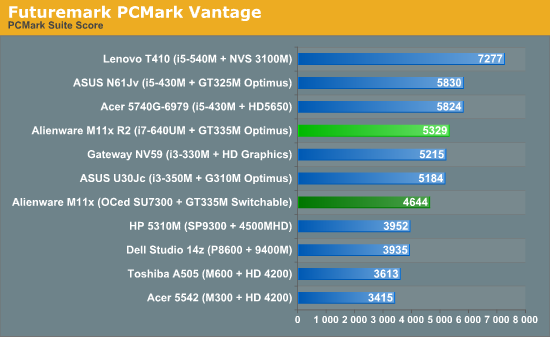
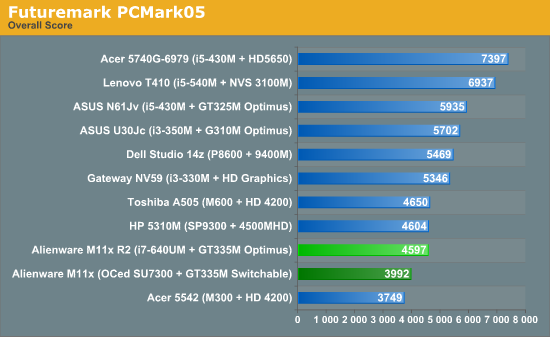

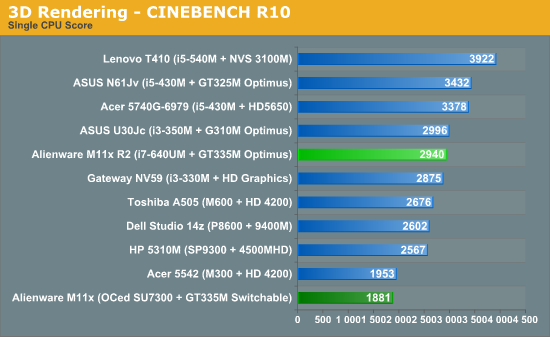
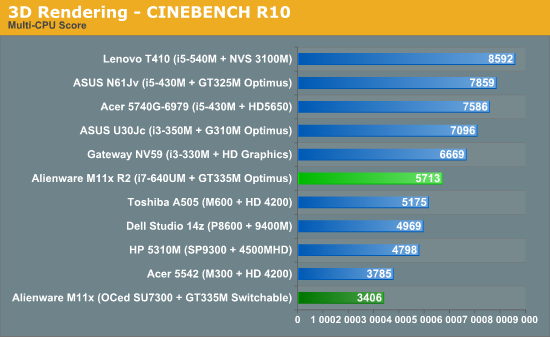
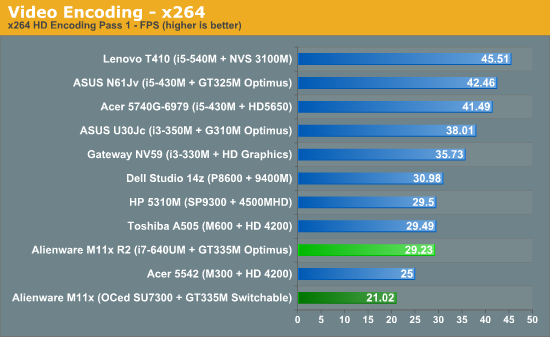
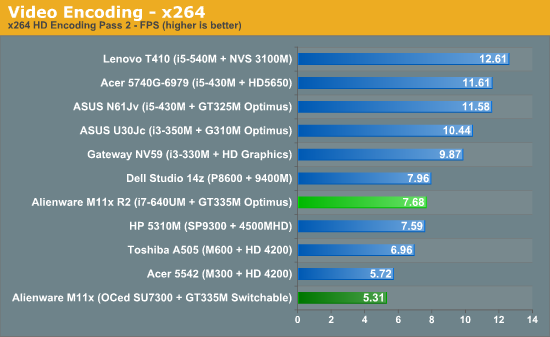
Both PCMark results improve by 15%, but they're at the lower end of the improvement scale. Peacekeeper shows the benefit of Turbo Boost, with 51% faster scores on the R2. Likewise, Cinebench is 56% faster on the 1CPU test, and Hyper-Threading plus Turbo Boost improve the multi-core rendering score by 68%. Rounding things out, x264 encoding also benefits from HTT and Turbo modes, with 39% and 45% faster encoding in pass one and two respectively. If you opt for the standard i5-520UM model, we expect scores will drop at least 10%, and perhaps as much as 20%, so keep that in mind.
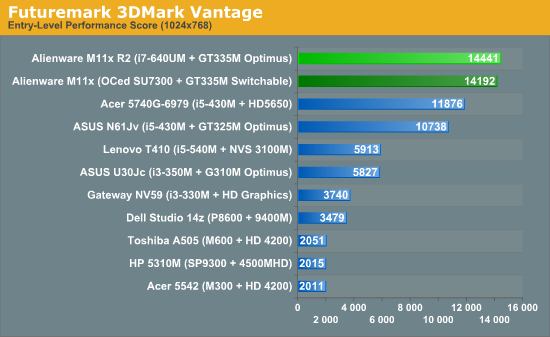
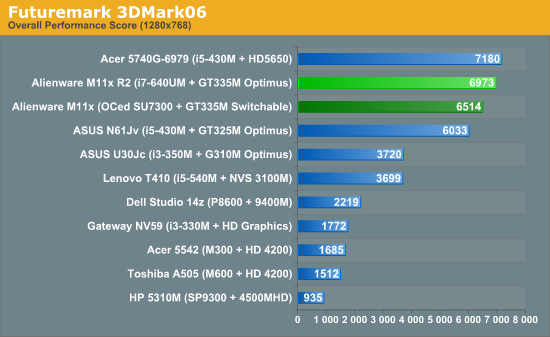
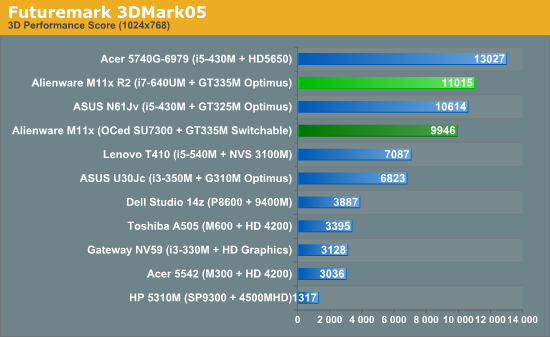
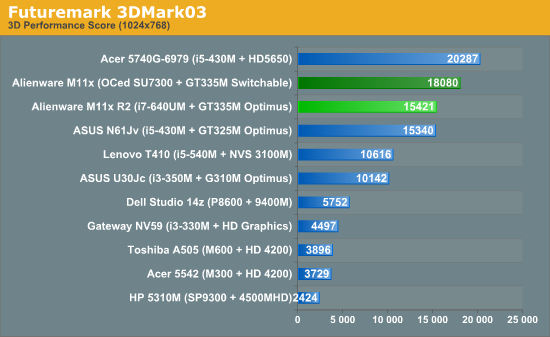
A quick look at 3DMark results confirms our gaming scores. 05, 06, and Vantage all have the R2 leading by a small amount—11%, 7%, and 2% respectively. Meanwhile, again we have a situation where an older application with higher frame rates runs slower on the R2. 3DMark03 is 17% faster on the original M11x, and while we don't "play" 3DMark it suggests that the process of transferring frames over the PCI-E bus to the IGP frame buffer is likely limiting performance. If you recall, Optimus doesn't have any direct connections to the displays, letting all of those go through the IGP. It's what allows the instantaneous switch between IGP and dGPU with no screen flicker. The catch is that all the frames go over the PCI-E bus. That's not a problem when you run at reasonable settings and get frame rates of under 60FPS, as you're only looking at around 250MB/s of data on a bus capable of handling 8000MB/s. However, theoretical performance and practical performance are different matters, and with the game tests on 3DMark03 running at anywhere from 110 to 350 FPS congestion seems likely.
We looked at the detailed results for 3DMark03, and sure enough it's the Game 1 test that shows the biggest drop. On the original it ran at 348FPS while it gets just 179FPS on the R2. The other results are closer; Game 2 runs at 136 vs. 128, Game 3 at 112 vs. 110, and Game 4 at 135 vs. 108—with the R1 beating the R2 in all four tests. This also appears to confirm that the lower scores in our Empire: Total War and STALKER: Call of Pripyat games (at minimum detail where frame rates are high) are not a driver issue so much as a PCI-E congestion issue. Again, this isn't a problem when you're playing games at reasonable frame rates (you don't really need more than 60FPS on typical LCDs), but we found it interesting nonetheless.










55 Comments
View All Comments
JarredWalton - Friday, July 9, 2010 - link
It's going to come down to whether you value Optimus and regular driver updates from NVIDIA. I suspect the i5-520UM will be slightly faster in applications but that's about it. I do, so I'd go for the Fast Track R2; Linux people will want the original though. Another thought: grab the original and buy your own SSD for about the same price as the Fast Track... would be nice. :-)SlyNine - Friday, July 9, 2010 - link
I wish you guys would test for throttling on the CPU and GPU under load. After the whole XPS16 Studio deal. When plugged in it was slower then on battery, it could clock down as low as 300mhz while trying to play a game. Turning almost every game in to a studdering mess. Then it turns out this is COMMON practice for Dell. Other systems have done this as well.Throttlestop by unclewebb is the easiest way to check for it.
Shadowmaster625 - Friday, July 9, 2010 - link
Intel is really dropping the ball here with arrandale ULV. There is no compelling reason to not choose a SU7300, up until Intel stops making SU7300s.Roland00 - Friday, July 9, 2010 - link
all evidence points towards the fact that Intel wasn't quite ready for 32nm due to the canceling of the notebook version of nehalem 45nm (Auburndale) and the mainstream dual core nehalem 45nm (Havendale). Now when Intel announced they were canceling Auburndale and Havendale they were doing so for is 32nm replacement Arrandale (mobile) and Clarksdale (desktop) were comming around nicely and they didn't need a 45nm version.The evidence points to the contrary, there is too much leakage on 32nm thus you can actually get better battery life with the 45nm chips. Then again Intel is doing 32nm so much better than TMSC is doing their 40nm bulk (not really comparable, but TMSC really messed up with this one) and there 32nm chips are still awesome just not as great as they looked on paper.
cjl - Friday, July 9, 2010 - link
Not at all. Intel's 32nm is definitely lower leakage and power than their 45nm. The problem is that the Nehalem architecture is more power hungry than Core. This more than offsets the advantages from changing processes to 32nm.If you need proof that 32nm is more power efficient than 45nm, just look at the i7-980x vs the i7-975. Same clock speed and 50% more cores, and it doesn't use any more power.
HexiumVII - Friday, July 9, 2010 - link
I had the R2 for about a month. It was pretty nice and turned heads with the dancing lights. Overall its quite nice for the road warrior. The trackpad was surprisingly good after playing with the M17. A few things made me return it. First battery life I could only eek out about 5 hours at most, with internet browsing in todays world, you can get a little over 4. Its quite heavy for it's size, a lb or so less would be awesome, any lighter and it would be hard to balance. It really has room for a bigger screen. Viewing angles, contrast, are all very acceptable compared to most other models under $2k out there. The Geforce 335 is a bit dated and slow, need something a little faster. Needs USB3.0/eSata/gigabit to get things on this bugger faster. I had an Intel G2 in there and it felt a tad bit faster, battery life didnt improve much. Its hard to do that many things on an 11inch screen.Probably going to get a new Acer TimelineX or Sony Z. Or a new Tablet if something exciting comes out in the next two months.
bakareshi - Thursday, July 15, 2010 - link
"The Geforce 335 is a bit dated and slow"The GT 335m that your R2 sported was by no means dated or slow for this category of notebook. In fact, the GT335m debuted in the m11xr1 that began shipping in the second quarter of this year. As for GPU speed, there is nothing faster offered under a 13" form factor. The 13" Vaio Z is the closest competitor, which still sports a slower GPU for about a thaousand dollars more.
fire400 - Friday, July 9, 2010 - link
This laptop is a piece of junk.plewis00 - Friday, July 9, 2010 - link
Sounds like jealousy from not being able to afford this 'piece of junk', strange because maybe 80-90% of the people who use or see this machine either want it or buy it...erple2 - Saturday, July 10, 2010 - link
You'll need to provide sources to back up that 80-90%.:)
However, it's just as much hyperbole as fire400 put forth, so that's ok..